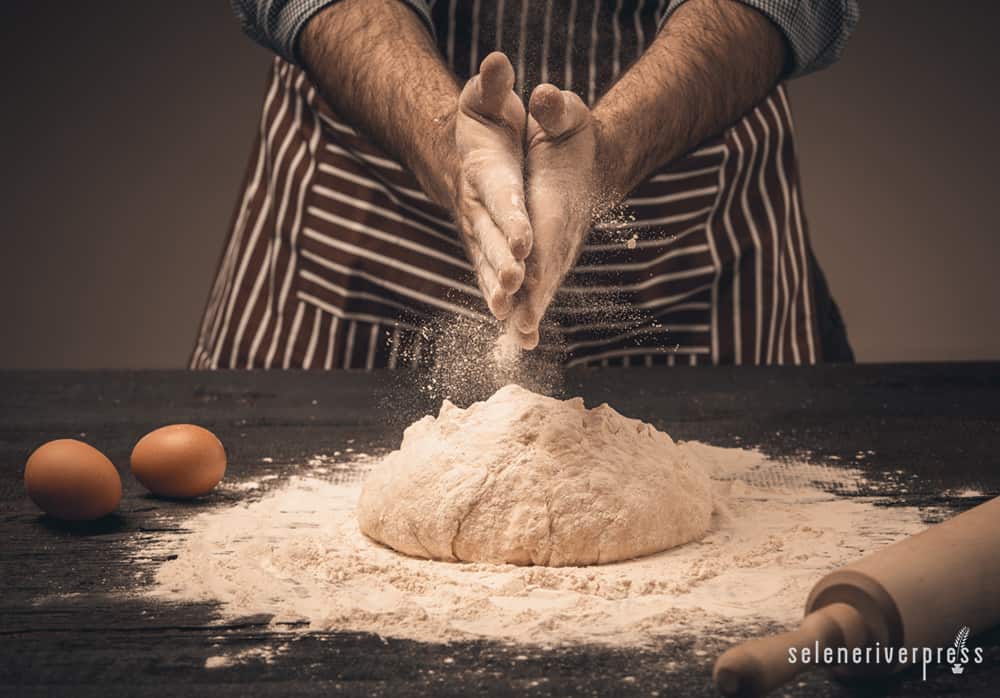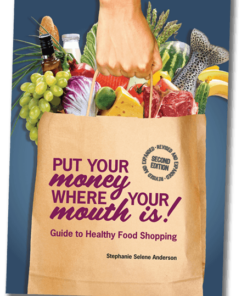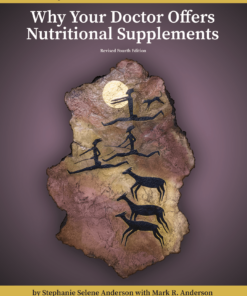When you think about food, do you sometimes feel like you live in two worlds at the same time? One is a colorful world of healthy food that’s full of nutrients. The other is a black-and-white world of unhealthy food that’s devoid of nutrients. In one of these worlds, bread is the staff of life. In the other, bread is an imposter that promises health while depriving you of nutrients.
The following selection from my book Put Your Money Where Your Mouth Is! A Guide to Healthy Food Shopping! will help you keep track of the world you’re living in:
The latest advance in our quest for superior nutrition through grains is organic heirloom grains (more accurately termed “landrace” grains). These are the strains of grains that gave way to the term “staff of life.” This excerpt from the article “What You Need to Know About Wheat” by Glenn Roberts, founder of Anson Mills, gives you a good idea about the grains that once nourished civilizations:
“Pre-industrial farmers were bakers and brewers as well, and did not grow a single variety of wheat in just one field. The best of them followed a tradition carried forward by grain women known as the Brewsters of the British Isles, who were talented enough to combine more than two hundred varieties of wheat in a single field and keep them all straight. The Brewsters selected entire wheat populations—not just varieties—for individual and combined taste, with special characteristics for brewing and bread baking, and for survivability. The tradition of the Brewsters, which came to be known as landrace farming and mass population selection, was brought to colonial America and was performed not by scientists and technicians, but by farmers and eaters. This system represents a body of knowledge amassed from antiquity, and, sadly, its methods and applications have been nearly lost in modern times.
“Today, we’re inclined to describe the Brewsters’ old farm crops and their cropping systems with a number of rather imprecise terms—‘heirloom,’ ‘traditional,’ ‘heritage’—because there are no official definitions or designations for them here in the United States. The term ‘landrace,’ however, represents a classification of crops and farming systems broadly present before industrialization, and carries nuances from each of the terms above. For these reasons, ‘landrace’ best describes the Brewster-style grower-only approach to farming.”
Hearty breads made from the seeds of beautiful grasses such as red fife, buckwheat, and spelt were once a staple of civilization. Today, the bread on our grocer’s shelf is a far cry from that ideal. Made from stale, refined, enriched, bleached flour, most commercial bread is devoid of nutrients and indigestible. Plus, almost all of us are allergic to it in some way.
The sad fact is that modern wheat is bred for high protein, high gluten, and high yield rather than maximum nutrition. The bran and germ are then removed, leaving little more than starch behind. Finally, it’s “enriched” with a sprinkling of synthetic vitamins baked into the imposter that far too many children today think of as bread.
In ancient Greece, Hippocrates once recommended stone-ground flour—complete with its vitamins, minerals, bran, and dietary fiber—for its beneficial effects on the digestive tract. Today’s commercial flour has very little fiber left in it—then when people get constipated, they buy bran and fiber as a remedy!
Although most health food stores don’t carry bleached white flour, they do sell plenty of unbleached refined white flour and refined flour products. Unbleached white flour is still a refined food, just like organic pasteurized milk is still a denatured food.
All of these are excellent reasons why you should consider investing in a home flour mill. If you love the smell and nourishment of home-baked bread (or want to discover it for the first time), there’s no better way to go. Why? Because flour is as perishable as a freshly cut apple. The oils in the germ start to go rancid within twenty minutes, so you must use it almost immediately after grinding in order to preserve all that grain goodness. With a flour mill at your disposal, you’ll be able to make the freshest cereals and flours in very little time.
If you decide to invest in your own mill, keep in mind that the oils in freshly milled flour will go rancid in two days if left in a cupboard at room temperature. You can preserve it somewhat with refrigeration or freezing, but certain nutrients are degraded by freezing temperatures. Freshly milled flour is the best way to capture the most nutrition from whole grains.
My first home grain mill was a Lee Household Flour Mill, the first electrically powered flour mill designed for home use. Royal Lee Organics by Standard Process just released an updated model, which still features Dr. Lee’s automatic feed design. Just pour grain in the hopper, set your texture, and turn it on. This stone mill efficiently reduces the entire grain kernel into nutritious, fine flour that does not require sifting. It’s easy to clean, and it’s very handsome.
For those times when you can’t make your own bread, make sure you shop for a source of high-quality whole grain bread. But keep in mind that, as previously noted, the oils in perished flour are rancid from oxygenation. That’s why you always want to find out how long the flour sat around after grinding before it was made into bread or other baked goods.
The tastiest, easiest to digest, and most nutrient rich bread is made using some form of sourdough starter, or “preferment,” instead of baker’s yeast. When you add water to flour and let it sit out in a warm room, naturally occurring wild yeasts and lactobacilli go to work. The fermentation creates a leavening agent (the starter) that can then be added to the bread recipe. Sourdough and other starters are usually made with whole grain flour but can also be made with white flour. At the end of this post you’ll find a basic, foolproof recipe we’ve been using for at least a year. You can use whatever whole grains you like in it and it contains a link to instructions for making sourdough starter.
Why all the fuss about fermentation methods for bread making? The reason is an important one: cereal grains contain antinutrients such as phytic acid, an enzyme inhibitor that interferes with the intestinal absorption of minerals such as calcium and magnesium. Unlike grazing animals, generally we humans do not produce phytase, the enzyme that naturally breaks down phytic acid, in our gastrointestinal tract. Fortunately, however, the bran in cereal grains contains phytase, and the enzyme is released when the grain is properly soaked or naturally leavened (that is, not with commercial yeast). This helps make the grain digestible and its nutrients biologically available.
Fermentation might even knock out gluten! A number of scientific studies over the past fifteen years have shown that during sourdough fermentation of long periods, lactic-acid–producing bacteria break gluten proteins down, sometimes so much that people suffering celiac disease (extreme gluten intolerance) can eat the fermented bread without reaction. While these studies have been small, and more extensive research is required (and surely to come), evidence suggests that sourdough bread may be a good nutritional choice for at least some gluten-sensitive individuals.
Many gluten intolerant individuals report, in fact, that they can tolerate certain sourdough breads. Of course, even people without gluten sensitivity complain of digestive distress after eating commercial, yeasted bread. Perhaps these facts underscore the fact that too many of us are eating the wrong kind of bread in the first place—and that is the cause of our distress.
Another benefit of fermentation is that breads made with whole grain flours in this tradition keep longer than breads made with baker’s yeast due to the lactic acid produced by the lactobacilli. Make your own starter and bake bread at home, or ask your health food store to carry sourdough, desem, and levain breads. You can also search local bakeries or online sources for these naturally fermented loaves.
So don’t shop and waste your money in the world of foodless foods when you can thrive in living color on real food.
Chef Briana Goodall’s Whole Grain Sourdough Bread
This recipe was developed at an altitude of approximately 5000 feet.
Ingredients
4¼ oz. (120 grams) mature, refreshed sourdough starter (see note below)
3½ teaspoons (20 grams) salt
2 cups (506 grams) tepid water
4½ cups (580 grams) freshly milled whole grain flour of your choice, single grain or a blend of grains
½ cup (70 grams) vital wheat gluten (optional, for a lighter loaf and increased loft)
Oil for bowl
Additional flour, for dusting top of loaf
Baking stone
Parchment paper
*To refresh starter: Feed starter twice, every 8 hours or so. Let sit at room temperature to refresh if using starter straight from the fridge. I feed in the evening on a Monday, then again Tuesday morning for use on Tuesday evening.
Instructions
- Combine starter, salt, water, flour, and gluten (if using) in the bowl of a stand mixer. If kneading by hand, use a large stainless or glass mixing bowl. Stir together to form a loose dough.
- Knead dough until elastic and smooth, about 10 minutes in a stand mixer, just more than 15 minutes if kneading by hand.
- Roll dough into a ball and place in a greased bowl. Cover bowl with plastic wrap and let rest for about an hour at room temperature.
- Invert a sheet pan and line with parchment paper. Roll dough into a loaf shape and place on inverted pan. Dust top of loaf with flour and score a few slits with a sharp knife into loaf. Cover loosely with a tea towel, then cover in plastic wrap and let sit overnight at room temperature. The final proof or rising time varies depending on your altitude. At 5,000 feet, the ideal rise time is 15 hours for a lighter loaf. At 12 hours, the loaf is good, but denser. Your rise time may vary based on altitude.
- In the morning, place a baking stone on the middle rack of the oven. Place a pan of hot water to the side of the stone on the same rack or the one below. Preheat the oven to 425F.
- When oven is preheated, gently slide loaf, on the parchment paper, onto the hot baking stone. Rustle the pan of hot water to create some good steam, then gently close the oven door. Bake for 20 minutes, then turn loaf 180 degrees. Bake 20 more minutes or so, until the loaf sounds hollow when thumped on the bottom. Alternately, test interior of loaf with an instant-read thermometer. It should read 190°F.
- Remove bread from oven and let cool on a rack at room temperature until ready to serve. Place in a bread bag, a plastic bag, or “green” bag once loaf is thoroughly cooled for prolonged freshness.
Image from iStock/nazarovsergey (main image).







Is there a good book you recommend?
James, a good one to start with is Sally Fallon’s Nourishing Traditions: https://www.seleneriverpress.com/shop/nourishing-traditions-the-cookbook-that-challenges-politically-correct-nutrition-and-the-diet-dictocrats/? Pages 483-494 have 18 different bread recipes, the importance of sourdough vs yeast breads, and page 573 has bread and rice cake recipes. I’ve relied so much on recipes handed to me by friends and fellow breadies that I don’t have any other specific book. But I’m asking around and if I find something, I’ll get back to you. Let us know how you do!
James, this book is great for technique: https://www.amazon.com/Peter-Reinharts-Whole-Grain-Breads/dp/1580087590
i just want to say thank you for helping promote the truth about food. i was turned onto organic gardening in the 60’s by my brother in law from Belgium. i was the oddball for many years, always seeking truth about growing practices and food, including the connection to health and environment. i have just now found you. i will share however i can, the ocean is made of droplets of water. thank you, thank you, thank you.
And thank YOU, Nita! It’s always heartwarming when someone is excited to have found us. We have so much to share and teach! Please feel free to contact me anytime: sanderson@seleneriverpress.com. Happy hunting!